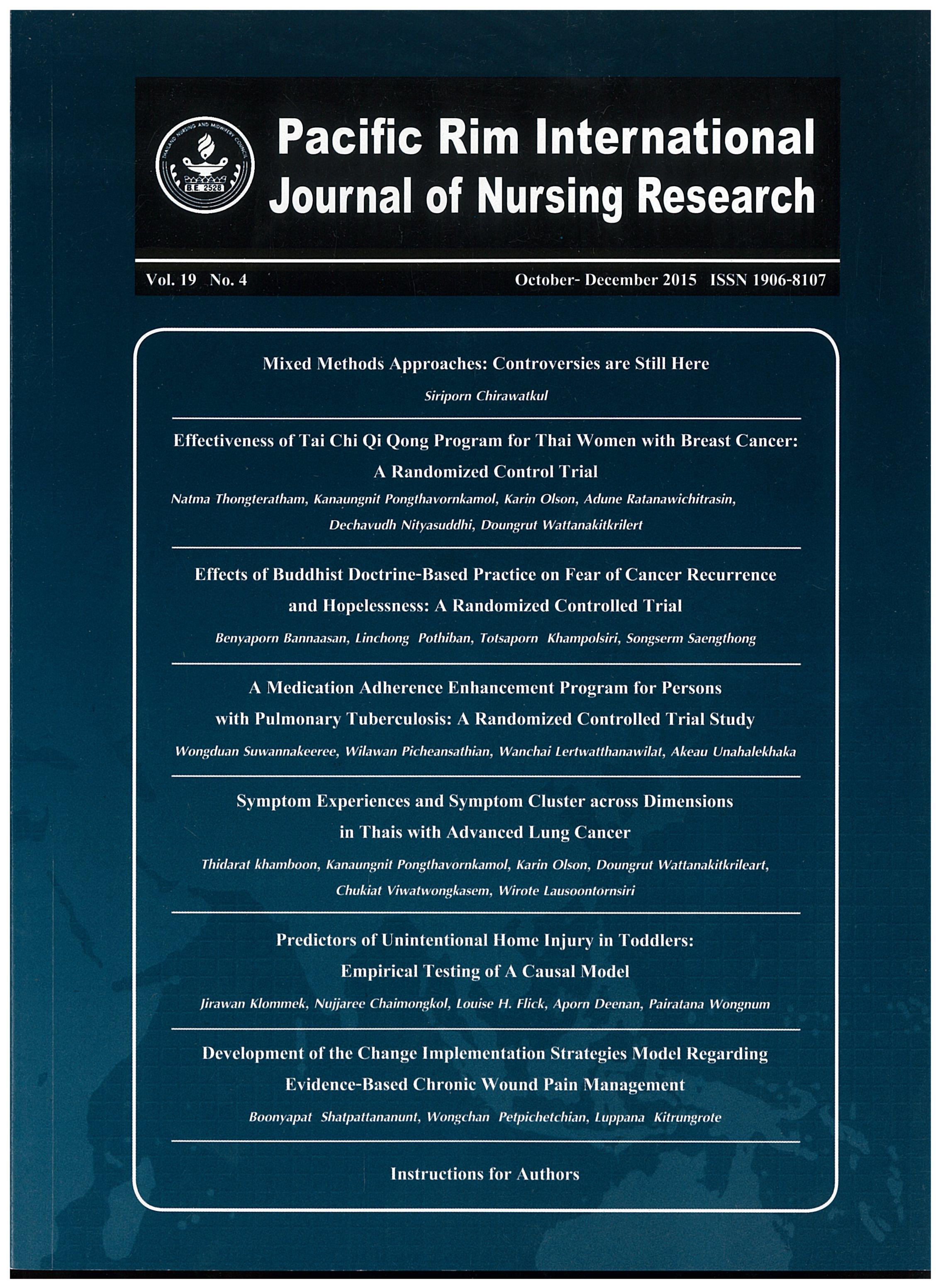Predictors of Unintentional Home Injury in Toddlers: An Empirical Test of A Causal Model
Keywords:
Child temperament, Parental protectiveness, Parental supervision, Thailand, Toddlers, Unintentional home injuryAbstract
The purpose of this study was to test the Klommek Model of Unintentional Home Injury in Thai Toddlers, a model expanding the work of others. Most unintentional home injury to toddler studies have shown complicated interactions among child attributes, parental supervision attributes, and home physical hazards. However, no set of predictors of unintentional home injury has been clearly investigated empirically. This study’s sample consisted of 247 mothers of 1-3 year-old children living in Bangkok. Mothers were interviewed with seven questionnaires: A Demographic Questionnaire, Child’s Temperament for Injury Risk, Parental Protectiveness, Parental Supervision, Parental Tolerance for Child’s Risk Taking, Parental Fate Belief, and Unintentional Home Injury in Toddlers. Additionally, mothers’ homes were naturalistically observed, guided by The Home Physical Hazard Checklist. Data analysis used descriptive statistics and Structural Equation Modeling to explore direct and indirect effects on unintentional home injury risk in toddlers. Results indicate that child temperament had the greatest significant direct (positive) effect on unintentional home injury while parental supervision and protectiveness had significant direct negative effects. Parental supervision mediated the link between child temperament and parental protectiveness and unintentional home injury. Finally, a modified Model accounted for 37% of the overall variance in the prediction of unintentional home injury in Thai toddlers. In conclusion, while validation in other samples is warranted, these findings suggest that nurses and other health policy makers should target the caretakers of toddlers for education to prevent home injury.
References
2. Public Health England. Guidance reducing unintentional injuries among children and young people [Internet]. London: The guidance; 2014. Reducing unintentional injuries in and around the home among children under five years [cited 2015 Jun 20]. Available from: https://www.gov.uk/government/uploads/system/uploads/attachment_data file/322210/Reducing_unintentional_injuries_in_and_around_the_home_ among_children_under_five_years.pdf
3. Sangsupawanich P. General health status. In report on the fourth Thai citizen health survey by physical examination, 2008-2009. Nonthaburi: NHESO; n.d, pp. 81-8.
4. Bureau of Non Communicable Disease (NCD), Department of Disease Control. Annual Report 2010. Bangkok: WVO Office of Printing Mill; 2011.
5.McKenzie JF, Pinger RR. An introduction to community and public health. 8th ed. MA: Jones & Bartlett Learning; 2015.
6. Smithson J, Garside R, Pearson M. Barriers to, and facilitators of, the prevention of unintentional injury in[children in the home: a systematic review and synthesis of qualitative research. Inj Prev. 2011; 17(2): 119-26.
7. Morrongieollo BA, McArthur BA. Parent supervision to prevent injuries. Parenting skills: University of Guelph;[2nd ed. 2014 December; cited 2015 March]. Available from https://www.child-encyclopedia.com/parenting-skills/according-experts/parent-supervision-prevent-injuries
8.Phelan KJ, Khoury J, Xu Y, Liddy S, Hornung R, Lanphear BP. A randomized controlled trial of home injury hazard reduction: the home injury study. Archives of Pediatric and Adol. Med. 2011; 165(4): 339-45.
9. Garzon DL. Contributing factors to preschool unintentional injury. J. of Pediatric Nurs. 2005; 20(6): 441-47.
10. Kuhn J, Damashek A. The role of proximal circumstances and child behavior in toddlers’ risk for minor unintentional injuries. Inj Prev. 2015; 21(1): 30-4.
11. Simpson JC, Nicholls J. Preventing unintentional childhood injury at home: injury Circumstances and intervention. Intern. J. of Injury and Safety Promotion. 2012; 19(2): 141-51.
12. Jonkheijm A, Zuidgeest JJH, van Dijk M, van As AB. Childhood unintentional injuries: supervision and first aid provided. African J of Paed. Surg. 2013; 10(4):339-44.
13. Hockenberry MJ, Wilson D. Wong’s essentials of pediatric nursing. 9th ed. Missouri: Elsevier Inc; 2013.
14. Morrongiello BA, Ondejko L, Littlejohn A. Understanding toddlers’ in-home injuries: I. Context, correlates, and determinants. J of Pediatric Psych. 2004; 29(6): 415-431.
15. Morrongiello BA, Klemencic N, Corbett M. Interactions between child behavioral patterns and parent supervision: Implications for children’s risk of unintentional injury. Child Dev. 2008; 79(3): 627-638.
16. Kamal NN. Home unintentional non-fatal injury among children under 5 years of age in A rural area, El Minia Governorate, Egypt. J Community Health. 2013; 38(5): 873-79.
17. Wang H, Liu XX, Liu YX, Lin Y, Shen M. Incidence and risk factors of non-fatal injuries in Chinese children aged 0-6 years: a case-control study. Injury. Int. J. Care Injured. 2011; 42(5): 521-24.
18. Schnitzer P, Dowd MD, Kruse RL, Morrongiollo BA. Supervision and risk of unintentional injury in young children. Inj Prev. 2015; 21(e1): e63-70.
19. Morrongiello BA, Corbett M. The parent supervision attributes profile questionnaire: A measure of supervision relevant to children’s risk of unintentional injury. Inj Prev. 2006;12(1): 19-23.
20. Morrongiello BA, Corbett M, Brison RJ. Identifying predictors of medically-attended injuries to young children: do child or parent behavioral attributes matter? Inj Prev. 2009; 15(4): 220-5.
21. Ablewhite J, Peel I, McDaid L, Hawkins A, Goodenough T, Deave T, et al. Parental Perceptions of barriers and facilitators to preventing child unintentional injuries within the home: a qualitative study. BMC Publish Health. 2015; 15(280): 1-9.
22. Blunch NJ. Introduction to structural equation modeling using IBM SPSS statistics and Amos. 2nd ed. Los Angeles: SAGE; 2013.
23.Speltz ML, Gonzales N, Sulzbacher S, Quan L. Assessment of injury risk in young children: A preliminary study of the injury behavior checklist. J of Pediatric Psych. 1990; 15(3): 373-383.
24. Phelan KJ, Khoury J, Xu Y, Lanphear B. Validation of a HOME injury survey. Injury Prevention. 2009; 15(5): 300-6.
25. Morrongiello BA, House K. Measuring parent attributes and supervision behaviors relevant to child injury risk: Examining the usefulness of questionnaire measures. Injury Prevention. 2004; 10(2): 114-8.
26. Glik D, Kronenfeld J, Jackson K. Predictors of risk perception of childhood injury among parents of preschool. Health Education Quarterly. 1991; 18(3): 285-301.
27.Damashek A, Khun J. Toddlers’ unintentional injuries: the role of maternal-reported paternal and maternal supervision. J. of Pediatric Psych. 2013; 38(3): 265-75.
28. Phuphaibul R, Wittayasooporn J, Choprapawon C. Consistency analysis of parenting styles in Thailand during children’s first year. Nurs Health Sci. 2012; 14(3): 405-11.
Downloads
Published
How to Cite
Issue
Section
License
Copyright: The Pacific Rim International Journal of Nursing Research, Thailand Nursing & Midwifery Council has exclusive rights to publish, reproduce and distribute the manuscript and all contents therein.







.png)


